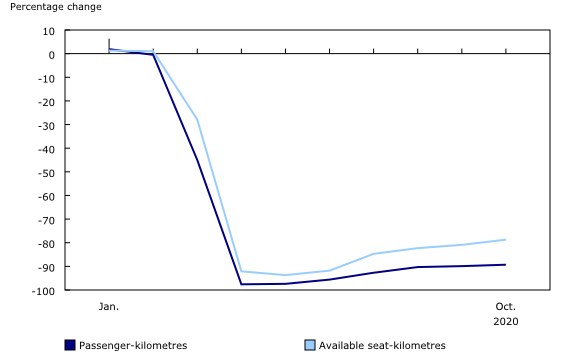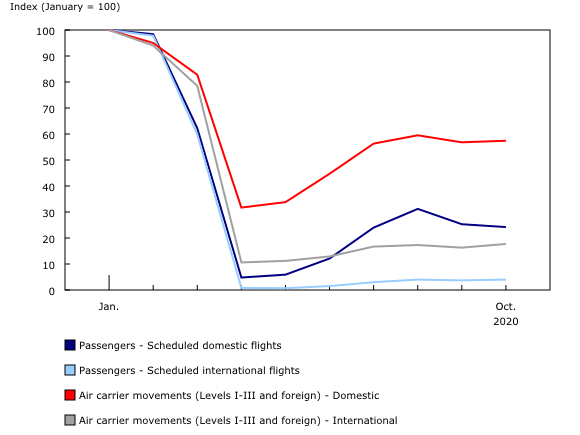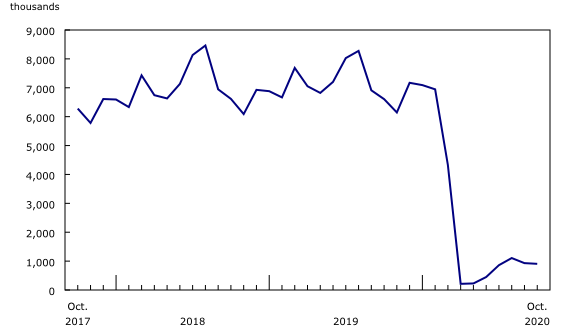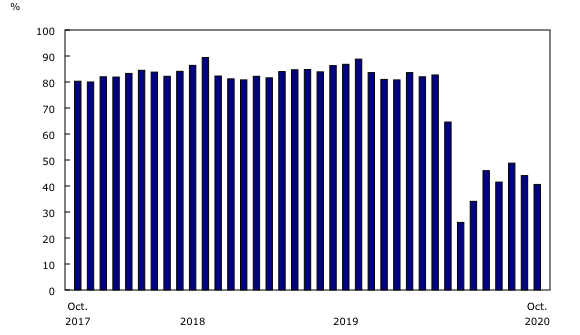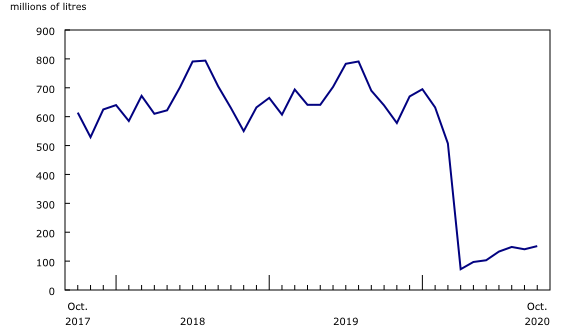Monthly civil aviation statistics, October 2020
Archived Content
Information identified as archived is provided for reference, research or recordkeeping purposes. It is not subject to the Government of Canada Web Standards and has not been altered or updated since it was archived. Please "contact us" to request a format other than those available.
Released: 2020-12-22
Highlights
In October, air travel remained essentially flat as major Canadian airlines carried 906,000 passengers on scheduled and charter services. This was down 86.3% from the same month in 2019, and—similar to a typical seasonal decline—down 2.6% from September.
As in previous months, most travel was domestic as international demand remained generally weak amid border travel restrictions and quarantine enforcements.
Compared with October 2019, air traffic fell to 1.8 billion passenger-kilometres, pushing operating revenues down 82.6% to $330.6 million in October.
Recovery in demand lags capacity
When travel restrictions were implemented in March, demand for travel dropped faster than capacity. Then, as airlines slashed schedules and grounded aircraft, capacity also declined sharply. After reaching a low point in April, demand for travel slowly increased while, at the same time, airlines offered more flights.
However, the increase in capacity (available seat-kilometres) outpaced the gain in demand (passenger-kilometres), which widened the gap. In response, Canada's two biggest airlines cancelled hundreds of flights in September amid a resurgent health crisis that may prolong the industry's slump. Both carriers have also recently announced plans to scale back services further in 2021, particularly in Atlantic Canada.
Demand remains low amid resurgence of COVID-19
Canadian Level I air carriers flew 906,000 passengers on scheduled and charter services in October, down 86.3% from the same month in 2019. This mirrored the 86.5% decrease registered in September, and marked the eighth consecutive year-over-year monthly decline—a period with the sharpest drop on record.
In October, both domestic and international travel remained nearly flat compared with September. Similarly, while domestic air carrier movements (takeoffs and landings) at major Canadian airports have outpaced international movements since the beginning of the pandemic, the recovery in both sectors has slowed since mid-summer.
Traffic fell 89.3% year over year to 1.8 billion passenger-kilometres in October, while capacity contracted 78.7% to 4.5 billion available seat-kilometres.
As a result, the passenger load factor—the ratio of passenger-kilometres to available seat-kilometres—dropped to 40.6%, down sharply from the 81.0% registered in October 2019 and the lowest recorded since May.
Lower demand dampens all measures
With far fewer international flights available, each passenger travelled an average of 2,034 kilometres in October, down 22.3% from October 2019.
As the number of flying hours fell 78.1% to 39,000 in October, the volume of turbo fuel consumed declined 76.3% to 151.6 million litres.
Operating revenue earned by Level I carriers totalled $330.6 million in October, down 82.6% from $1.9 billion the same month a year earlier.
Note to readers
The Monthly Civil Aviation Survey covers all Canadian Level I air carriers: Air Canada (including Air Canada Rouge), Air Transat, Jazz, Porter, Sky Regional, Sunwing and WestJet (including Swoop, WestJet Encore and WestJet Link).
The number of air carriers increased from six in 2019 to seven in 2020, as one Level II air carrier was reclassified to Level I.
The average passenger trip length is obtained by dividing the number of passenger-kilometres by the number of passengers. Trips across Canada and the world are included in this calculation.
Data in this monthly release are not seasonally adjusted.
Data for the previous nine months have been revised.
Contact information
For more information, or to enquire about the concepts, methods or data quality of this release, contact us (toll-free 1-800-263-1136; 514-283-8300; STATCAN.infostats-infostats.STATCAN@canada.ca) or Media Relations (613-951-4636; STATCAN.mediahotline-ligneinfomedias.STATCAN@canada.ca).
- Date modified:



